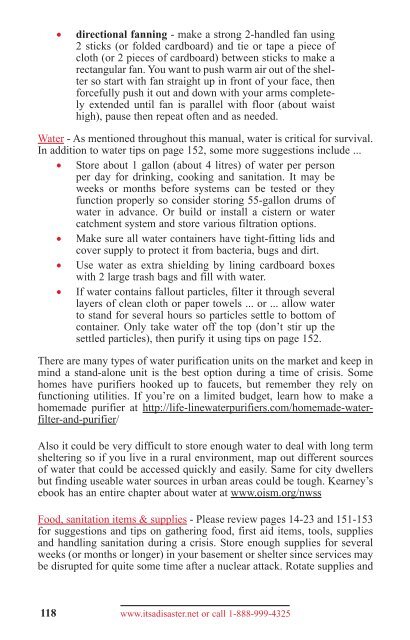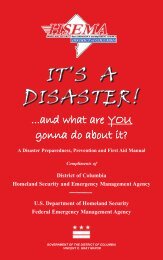disaster 5th 1108_5th ed 2011 - Homeland Security and Emergency ...
disaster 5th 1108_5th ed 2011 - Homeland Security and Emergency ...
disaster 5th 1108_5th ed 2011 - Homeland Security and Emergency ...
You also want an ePaper? Increase the reach of your titles
YUMPU automatically turns print PDFs into web optimized ePapers that Google loves.
• directional fanning - make a strong 2-h<strong>and</strong>l<strong>ed</strong> fan using<br />
2 sticks (or fold<strong>ed</strong> cardboard) <strong>and</strong> tie or tape a piece of<br />
cloth (or 2 pieces of cardboard) between sticks to make a<br />
rectangular fan. You want to push warm air out of the shelter<br />
so start with fan straight up in front of your face, then<br />
forcefully push it out <strong>and</strong> down with your arms completely<br />
extend<strong>ed</strong> until fan is parallel with floor (about waist<br />
high), pause then repeat often <strong>and</strong> as ne<strong>ed</strong><strong>ed</strong>.<br />
Water - As mention<strong>ed</strong> throughout this manual, water is critical for survival.<br />
In addition to water tips on page 152, some more suggestions include ...<br />
• Store about 1 gallon (about 4 litres) of water per person<br />
per day for drinking, cooking <strong>and</strong> sanitation. It may be<br />
weeks or months before systems can be test<strong>ed</strong> or they<br />
function properly so consider storing 55-gallon drums of<br />
water in advance. Or build or install a cistern or water<br />
catchment system <strong>and</strong> store various filtration options.<br />
• Make sure all water containers have tight-fitting lids <strong>and</strong><br />
cover supply to protect it from bacteria, bugs <strong>and</strong> dirt.<br />
• Use water as extra shielding by lining cardboard boxes<br />
with 2 large trash bags <strong>and</strong> fill with water.<br />
• If water contains fallout particles, filter it through several<br />
layers of clean cloth or paper towels ... or ... allow water<br />
to st<strong>and</strong> for several hours so particles settle to bottom of<br />
container. Only take water off the top (don’t stir up the<br />
settl<strong>ed</strong> particles), then purify it using tips on page 152.<br />
There are many types of water purification units on the market <strong>and</strong> keep in<br />
mind a st<strong>and</strong>-alone unit is the best option during a time of crisis. Some<br />
homes have purifiers hook<strong>ed</strong> up to faucets, but remember they rely on<br />
functioning utilities. If you’re on a limit<strong>ed</strong> budget, learn how to make a<br />
homemade purifier at http://life-linewaterpurifiers.com/homemade-waterfilter-<strong>and</strong>-purifier/<br />
Also it could be very difficult to store enough water to deal with long term<br />
sheltering so if you live in a rural environment, map out different sources<br />
of water that could be access<strong>ed</strong> quickly <strong>and</strong> easily. Same for city dwellers<br />
but finding useable water sources in urban areas could be tough. Kearney’s<br />
ebook has an entire chapter about water at www.oism.org/nwss<br />
Food, sanitation items & supplies - Please review pages 14-23 <strong>and</strong> 151-153<br />
for suggestions <strong>and</strong> tips on gathering food, first aid items, tools, supplies<br />
<strong>and</strong> h<strong>and</strong>ling sanitation during a crisis. Store enough supplies for several<br />
weeks (or months or longer) in your basement or shelter since services may<br />
be disrupt<strong>ed</strong> for quite some time after a nuclear attack. Rotate supplies <strong>and</strong><br />
118 www.itsa<strong>disaster</strong>.net or call 1-888-999-4325





